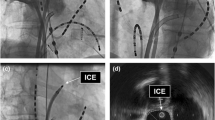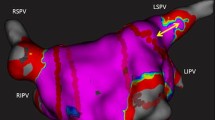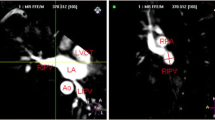Abstract
Purpose
Relationship between pulmonary vein (PV) anatomy and the pathophysiology of paroxysmal atrial fibrillation (PAF) remains incompletely studied. The aim of this study was to determine whether PV anatomy predicts arrhythmogenic PVs.
Methods
Twenty-six consecutive PAF patients with spontaneous PAF or consistently frequent ectopic beats during electrophysiological study were enrolled. Computed tomography (CT) images for PVs were reconstructed into 3D images. The PV diameter and volume were measured based on the 3D images. The PV myocardial sleeve area was measured based on the 3D voltage mapping results. The PV myocardial sleeve area index was calculated by dividing the sleeve area of each PV by the average sleeve area of all PVs in each patient.
Results
The diameter and volume of the arrhythmogenic PVs were larger than those of the non-arrhythmogenic PVs (21.08 ± 4.57 mm vs. 16.47 ± 3.31 mm, P < 0.001 and 7.70 ± 3.28 cm3 vs. 4.09 ± 1.99 cm3, P < 0.001, respectively). The myocardial sleeve area and sleeve area index of the arrhythmogenic PVs were also larger than those of the non-arrhythmogenic PVs (8.62 ± 5.33 cm2 vs. 4.77 ± 3.84 cm2, P < 0.001 and 1.59 ± 0.35 vs. 0.81 ± 0.38, P < 0.001, respectively). Multivariate analysis showed the PV myocardial sleeve area index was the independent predictor for arrhythmogenic PVs (P < 0.001).
Conclusions
PV size plays an important role in triggering PAF. A large myocardial sleeve extension is a powerful and independent predictor for arrhythmogenic PV, which may be useful anatomical markers to facilitate PAF ablation.





Similar content being viewed by others
References
Yamane T, Shah DC, Jaïs P, Hocini M, Peng JT, Deisenhofer I, et al. Dilatation as a marker of pulmonary veins initiating atrial fibrillation. J Interv Card. Electrophysiol. 2002;6:245–9.
Lin WS, Prakash VS, Tai CT, Hsieh MH, Tsai CF, Yu WC, et al. Pulmonary vein morphology in patients with paroxysmal atrial fibrillation initiated by ectopic beats originating from the pulmonary veins: implications for catheter ablation. Circulation. 2000;101:1274–81.
Roux N, Havet E, Mertl P. The myocardial sleeves of the pulmonary veins: potential implications for atrial fibrillation. Surg Radiol Anat. 2004;26:285–9.
Saito T, Waki K, Becker AE. Left atrial myocardial extension onto pulmonary veins in humans: anatomic observations relevant for atrial arrhythmias. J Cardiovasc Electrophysiol. 2000;11:888–94.
Steiner I, Hájková P, Kvasnicka J, Kholová I. Myocardial sleeves of pulmonary veins and atrial fibrillation: a postmortem histopathological study of 100 subjects. Virchows Arch. 2006;449:88–95.
Richmond L, Rajappan K, Voth E, Rangavajhala V, Earley MJ, Thomas G, et al. Validation of computed tomography image integration into the EnSite NavX mapping system to perform catheter ablation of atrial fibrillation. J Cardiovasc Electrophysiol. 2008;19:821–7.
Kistler PM, Earley MJ, Harris S, Abrams D, Ellis S, Sporton SC, et al. Validation of three-dimensional cardiac image integration: use of integrated CT image into electroanatomic mapping system to perform catheter ablation of atrial fibrillation. J Cardiovasc Electrophysiol. 2006;17:341–8.
Hunter RJ, Ginks M, Ang R, Diab I, Goromonzi FC, Page S, et al. Impact of variant pulmonary vein anatomy and image integration on long-term outcome after catheter ablation for atrial fibrillation. Europace. 2010;12:1691–7.
McLellan AJ, Ling LH, Ruggiero D, Wong MC, Walters TE, Nisbet A, et al. Pulmonary vein isolation: the impact of pulmonary venous anatomy on long-term outcome of catheter ablation for paroxysmal atrial fibrillation. Heart Rhythm. 2014;11:549–56.
Santangeli P, Zado ES, Garcia FC, Riley MP, Lin D, Frankel DS, et al. Lack of prognostic value of atrial arrhythmia inducibility and change in inducibility status after catheter ablation of atrial fibrillation. Heart Rhythm. 2018;15:660–5.
Chen SA, Hsieh MH, Tai CT, Tsai CF, Prakash VS, Yu WC, et al. Initiation of atrial fibrillation by ectopic beats originating from the pulmonary veins: electrophysiological characteristics, pharmacological responses, and effects of radiofrequency ablation. Circulation. 1999;100:1879–86.
Pappone C, Rosanio S, Oreto G, Tocchi M, Gugliotta F, Vicedomini G, et al. Circumferential radiofrequency ablation of pulmonary vein ostia: a new anatomic approach for curing atrial fibrillation. Circulation. 2000;102:2619–28.
Santangeli P, Marchlinski FE. Techniques for the provocation, localization, and ablation of non-pulmonary vein triggers for atrial fibrillation. Heart Rhythm. 2017;14:1087–896.
Haïssaguerre M, Jaïs P, Shah DC, Takahashi A, Hocini M, Quiniou G, et al. Spontaneous initiation of atrial fibrillation by ectopic beats originating in the pulmonary veins. N Engl J Med. 1998;339:659–66.
Haegeli LM, Calkins H. Catheter ablation of atrial fibrillation: an update. Eur Heart J. 2014;35:2454–9.
Gökoğlan Y, Mohanty S, Güneş MF, Trivedi C, Santangeli P, Gianni C, et al. Pulmonary vein antrum isolation in patients with paroxysmal atrial fibrillation: more than a decade of follow-up. Circ Arrhythm Electrophysiol. 2016;9:e003660.
Kumar S, Michaud GF. Catheter ablation for paroxysmal atrial fibrillation: time to focus more on trigger ablation? Circ Arrhythm Electrophysiol. 2016;9:e004129.
Kirchhof P, Benussi S, Kotecha D, Ahlsson A, Atar D, Casadei B, et al. 2016 ESC guidelines for the management of atrial fibrillation developed in collaboration with EACTS. Eur Heart J. 2016;37:2893–962.
Kautzner J, Neuzil P, Lambert H, Peichl P, Petru J, Cihak R, et al. EFFICAS II: optimization of catheter contact force improves outcome of pulmonary vein isolation for paroxysmal atrial fibrillation. Europace. 2015;17:1229–35.
Kuck KH, Brugada J, Fürnkranz A, Metzner A, Ouyang F, Chun KR, et al. Cryoballoon or radiofrequency ablation for paroxysmal atrial fibrillation. N Engl J Med. 2016;374:2235–45.
Suenari K, Lin YJ, Chang SL, Lo LW, Hu YF, Tuan TC, et al. Relationship between arrhythmogenic pulmonary veins and the surrounding atrial substrate in patients with paroxysmal atrial fibrillation. J Cardiovasc Electrophysiol. 2011;22:405–10.
Waktare JE, Hnatkova K, Sopher SM, Murgatroyd FD, Guo X, Camm AJ, et al. The role of atrial ectopics in initiating paroxysmal atrial fibrillation. Eur Heart J. 2001;22:333–9.
Narayan SM, Kazi D, Krummen DE, Rappel WJ. Repolarization and activation restitution near human pulmonary veins and atrial fibrillation initiation: a mechanism for the initiation of atrial fibrillation by premature beats. J Am Coll Cardiol. 2008;52:1222–30.
Gladstone DJ, Dorian P, Spring M, Panzov V, Mamdani M, Healey JS, et al. Atrial premature beats predict atrial fibrillation in cryptogenic stroke: results from the EMBRACE trial. Stroke. 2015;46:936–41.
Wallmann D, Tüller D, Wustmann K, Meier P, Isenegger J, Arnold M, et al. Frequent atrial premature beats predict paroxysmal atrial fibrillation in stroke patients: an opportunity for a new diagnostic strategy. Stroke. 2007;38:2292–4.
Vincenti A, Brambilla R, Fumagalli MG, Merola R, Pedretti S. Onset mechanism of paroxysmal atrial fibrillation detected by ambulatory Holter monitoring. Europace. 2006;8:204–10.
Sohns C, Sohns JM, Bergau L, Sossalla S, Vollmann D, Lüthje L, et al. Pulmonary vein anatomy predicts freedom from atrial fibrillation using remote magnetic navigation for circumferential pulmonary vein ablation. Europace. 2013;15:1136–42.
Igawa O. Focus on the atrial structure—useful anatomical information for catheter ablation—. J Arrhythm. 2011;27:268–88.
Hsieh MH, Chen SA, Tai CT, Tsai CF, Prakash VS, Yu WC, et al. Double multielectrode mapping catheters facilitate radiofrequency catheter ablation of focal atrial fibrillation originating from pulmonary veins. J Cardiovasc Electrophysiol. 1999;10:136–44.
Hsieh MH, Tai CT, Tsai CF, Yu WC, Lee SH, Lin YK, et al. Pulmonary vein electrogram characteristics in patients with focal sources of paroxysmal atrial fibrillation. J Cardiovasc Electrophysiol. 2000;11:953–9.
Huang W, Liu T, Shehata M, Zhang K, Yao Y, Niu G, et al. Inducibility of atrial fibrillation in the absence of atrial fibrillation: what does it mean to be normal? Heart Rhythm. 2011;8:489–92.
Kumar S, Kalman JM, Sutherland F, Spence SJ, Finch S, Sparks PB. Atrial fibrillation inducibility in the absence of structural heart disease or clinical atrial fibrillation: critical dependence on induction protocol, inducibility definition, and number of inductions. Circ Arrhythm Electrophysiol. 2012;5:531–6.
Leong-Sit P, Robinson M, Zado ES, Callans DJ, Garcia F, Lin D, et al. Inducibility of atrial fibrillation and flutter following pulmonary vein ablation. J Cardiovasc Electrophysiol. 2013;24:617–23.
Yasuoka R, Kurita T, Kotake Y, Hashiguchi N, Motoki K, Kobuke K, et al. Particular morphology of inferior pulmonary veins and difficulty of cryoballoon ablation in patients with paroxysmal atrial fibrillation. Circ J. 2017;81:668–74.
Alonso-Martín C, Rodríguez Font E, Guerra JM, Viñolas PX. Pulmonary vein isolation in cases of difficult catheter placement: a new pacing maneuver to demonstrate complete isolation of the veins. Heart Rhythm. 2013;10:1289–92.
Acknowledgments
We are grateful to the staffs of our electrophysiology laboratory for their support to this study.
Author information
Authors and Affiliations
Corresponding author
Ethics declarations
The protocol of the present study was approved by the Institutional Review Board of China Medical University Hospital in Taiwan. The investigation conformed to the principles outlined in the Declaration of Helsinki.
Additional information
Publisher’s note
Springer Nature remains neutral with regard to jurisdictional claims in published maps and institutional affiliations.
Rights and permissions
About this article
Cite this article
Chen, JY., Wu, HD.I. & Chang, KC. Pulmonary vein volume and myocardial sleeve extension estimated by 3D computed tomography and voltage mapping predict arrhythmogenic triggers of paroxysmal atrial fibrillation. J Interv Card Electrophysiol 62, 177–185 (2021). https://doi.org/10.1007/s10840-020-00892-x
Received:
Accepted:
Published:
Issue Date:
DOI: https://doi.org/10.1007/s10840-020-00892-x




